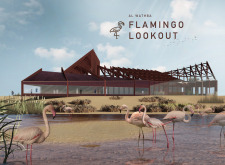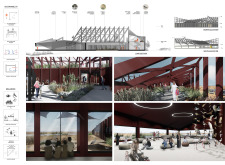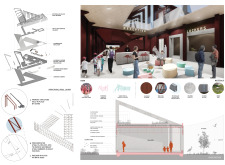5 key facts about this project
This architecture represents a thoughtful response to its natural surroundings, integrating with the environment while promoting awareness and conservation of the region's ecological heritage. Functionally, the lookout offers various spaces for visitors, including educational facilities, observation decks, and interactive areas designed to foster learning about the unique ecosystem.
A defining aspect of this project is its architectural design, which draws inspiration from the movement and grace of flamingos. The building's form features an innovative roof structure composed of interlocking triangles that echo the dance-like movements of these birds. This unique approach to design not only creates an eye-catching silhouette but also serves a functional purpose by providing dynamic spaces for viewing the wetlands.
The materials chosen for the project are critical in conveying its intent while ensuring durability and sustainability. Utilizing rectangular hollow steel sections ensures structural integrity, while aluminum cladding offers weather resistance and a modern aesthetic. Polished concrete flooring complements the design by creating a seamless transition between indoor and outdoor environments. Furthermore, the inclusion of flushed glazing maximizes natural light, enhancing visibility and providing unobstructed views of the wetlands. The implementation of a green roof not only contributes to the building's thermal efficiency but also supports local biodiversity by allowing native flora to thrive.
Important areas within the lookout are purposefully designed to engage visitors. The ground floor welcomes individuals with a reception area, educational exhibits, and direct access to the observation decks. These spaces encourage interaction and facilitate learning about the significance of the flamingos and their habitat. The upper floor, featuring elevated viewing platforms, allows visitors to experience the wetlands from a new perspective, reinforcing their connection to nature.
The circulation within the design emphasizes accessibility, ensuring that all visitors can easily navigate the space. Pathways are meticulously planned to guide individuals through the building and into the surrounding environment, enhancing the overall experience. By integrating universal accessibility features, the architecture prioritizes an inclusive approach.
Unique design strategies are evident throughout the project. The emphasis on sustainability is paramount, with features such as natural ventilation and rainwater harvesting systems incorporated into the architecture. These elements not only reduce the building's ecological footprint but also highlight the project's commitment to respecting and preserving the delicate ecosystems of the wetlands.
The Al Wathba Flamingo Lookout stands as an exemplar of architecture that blends functionality and environmental sensitivity while promoting community engagement and education. It invites the public to explore and understand the significance of the Al Wathba Wetland Reserve, offering crucial insights into conservation efforts.
For those interested in a deeper understanding of this architectural project, we encourage you to explore the various architectural plans, sections, and designs that provide additional details about the thoughtful ideas behind this remarkable endeavor.


























